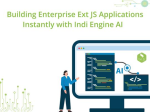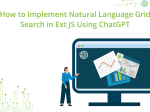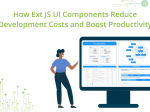Build Faster and Smarter with Rapid App Development Using Ext JS
Are you tired of spending endless hours writing complicated code for your web apps? Looking for a faster, simpler way to build? Meet Rapid Ext JS – a powerful rapid app development that’s changing the game. With its easy-to-use interface and drag-and-drop features, it makes development smoother than ever.
Good news – the Beta version of this amazing low-code tool for Ext JS is now ready to download!

Rapid Ext JS lets you build complex web applications without needing deep coding skills. It speeds up creating top-notch Sencha Ext JS enterprise apps with just simple drag and drop. Plus, it’s a Visual Studio Code (VS Code) extension, so it fits right into your workflow.
Find out how Rapid Ext JS can make your web development faster and easier and save you time and effort.
What Makes Rapid Ext JS a Game-Changer for Developers?
Rapid application development is a handy extension for Visual Studio Code designed to speed up the creation of Ext JS applications. It’s a low-code tool with a simple, lightweight graphical interface that helps developers spend less time writing code by hand. With support for over 140 Ext JS components, you can easily build your app by dragging and dropping elements and instantly see how everything looks with real-time previews.
The best part? The interface is clear & user-friendly, so even if you’re not an expert, you can quickly get started. Adding buttons, grids, forms, and other features becomes a smooth visual process that makes app building much faster and less stressful.
Packed with helpful features, Rapid Ext JS lets you create modern, professional web applications more efficiently – saving you time while still giving you full control over your project.
Take advantage of the opportunity to try it out and see what it can do for your projects!
What Sets Visual Studio Code Apart from Other?
It is a popular & lightweight code editor that works on Windows, macOS, and Linux. It’s packed with useful features, especially for JavaScript and Node.js developers, making coding faster & easier.
On top of that, the Rapid Ext JS extension for VS Code adds even more power for building Ext JS applications. It helps you generate basic code templates, offers a tailored editing experience, and lets you see live previews of your Ext JS views – all designed to make your development smoother and more efficient.
What Makes Rapid Ext JS Stand Out? Top Features Explained
Rapid Ext JS comes packed with several powerful features that help web developers work smarter and faster. Here are some of the standout benefits that make this tool a game-changer:
View Modes
Rapid web app offers three view modes – code, design, and split. This lets you switch between writing code, visually designing your app, or seeing both side-by-side. It makes it easier to understand and work on your application from different angles.
Zooming
Rapid App Development allows you to zoom out & in so that you can have the perfect view of your work. Whether you need to look at small details or to view the larger picture, it’s got you covered. You can zoom up to 500% to have a close-up or to 25% to have the entire layout displayed at once. This mobility makes it simpler to design & perfect your app in the way you desire.
Sencha Toolbox Reposition
With this functionality, you can move wherever it is most convenient to you – whether that is to the left, right, or below the design view. This gives you customize your workspace to your needs, allowing you to access the tools you need without interrupting the workflow.
Action Commands
Rapid Ext JS comes with four key action commands that help speed up your development process:
- Stopwatch: Tracks the time taken for various tasks, helping you monitor performance.
- Restart Watch: Restarts the automatic file watcher that keeps an eye on changes so your app stays updated as you code.
- Build Dynamic Packages: Creates optimized packages of your app dynamically, making your builds faster and more efficient.
- Run Build: Executes the full build process, preparing your application for deployment.
These commands simplify managing and testing your app during development.
Color Themes
One of the great features of the rapid web app development framework is that it supports a wide range of Visual Studio Code color themes. This allows you to customize the look of your editor according to your taste or minimize eye strain. Some of the popular themes you can select include:
- Abyss
- Light
- Dark
- Solarized Light
And many more!
This flexibility helps create a comfortable coding environment, whether you prefer a bright or dark workspace.
UX Components
Rapid application development tools come packed with a variety of UX components designed to make your applications more interactive & user-friendly. These ready-to-use components help you build rich interfaces without starting from scratch. Some of the key components include:
- Grid for displaying data in organized tables
- Panel to group content or controls
- Buttons for user interactions
- Data View for flexible data presentation
- Menu to create navigation options
- Carousel for sliding content or images
- Slider to select values smoothly
- And there are many more components available, giving you the tools to create polished, professional web apps quickly and easily.
What Exactly Is Low Code Development?
It is a method of software build that makes the process of making applications quicker and easier. Rather than writing large amounts of complicated code, you use visual components such as drag-and-drop elements and simple interfaces. This process allows developers, as well as non-technical individuals, to develop apps more quickly, cutting time & minimizing the requirement for deep programming skills.
What Are The Benefits Of Low Code Editor?
Best Low Code Development Platforms have numerous advantages that have made them a favorite among developers & business houses. Some of the key benefits include:
- It helps build apps faster, so projects get completed on time & teams can respond quickly to new business needs.
- They make app development easier, even for those without a strong coding background.
- Teams can work together better because rapid web application development tools are more accessible to both tech & non-tech users.
- They reduce costs by reducing the amount of manual coding needed.
- You can scale your apps easily as your business grows or changes.
- Pre-built components & templates help save time and effort during the development process.
- Debugging & testing have become simpler, thanks to visual tools and guided features.
- You can reuse components across multiple projects, which makes updates & maintenance smoother.
- There’s less need for complex setup – many platforms let you start building right away.
Low-code editors create rapid app development quicker, simpler & more collaborative. Whether you’re in a startup, an enterprise, or somewhere in between, these editors enable ideas to become a reality without the typical complexity or expense.
What Is The Comparison Of Low Code & No Code Development?
Low-code & no-code rapid web applications are changing the way we develop software by making it quicker, simpler & more accessible to build apps. Although they both minimize the use of manual coding, they serve differing levels of user need & technical expertise. Whether you are a professional or even a beginner, knowing the difference can help you in choosing the appropriate one for your application.
Here’s a simple comparison to assist you in understanding the fundamental differences between both:
| Feature | Low-Code Development | No-Code Development |
|---|---|---|
| Coding Required | Some coding required for customization | No coding required |
| Target Users | Developers and technically-skilled users | Non-developers, business users |
| Flexibility | High – allows custom coding and advanced logic | Limited – relies on predefined components |
| Speed of Development | Fast, but may require coding at certain points | Very fast – drag-and-drop only |
| Use Cases | Complex apps, internal tools, integrations | Simple apps, prototypes, basic workflows |
| Customization | Highly customizable | Limited customization options |
| Learning Curve | Moderate – basic programming knowledge helps | Low – easy for beginners |
| Maintenance | Requires occasional code updates | Minimal maintenance, depending on platform |
Both methods have great to offer based on your company’s requirements & staff skills. If you’re creating a complex, highly-featured with long-term objectives, it can provide the flexibility & control you require. If you want to build a tool or a prototype rapidly with minimal technical support, no-code can be an ideal option.
Ultimately, it’s not one choosing the other – it’s selecting the tool for the right task.
Is Low-Code Just for Developers? Here’s Who Can Actually Use It
Low-code editors are built to make application development simpler, so a wide range of people can use them – not just seasoned programmers. Here’s who can benefit:
Business Analysts
It gives business analysts the power to make their ideas a reality without necessarily having to possess extensive coding expertise. They can create prototypes or proof-of-concept applications to explore new concepts & investigate new ideas, validate workflows & create solutions that deliver value. This speeds up decision-making and fills the space between the technical team and business objectives.
Citizen Developers
Individuals with minimal to no coding experience can easily use this editor to develop operational apps. Not only does this decrease the need for IT departments, but it also empowers teams throughout the organization to resolve issues & enhance workflows independently. It’s a wonderful means of promoting innovation without requiring deep technical proficiency.
Professional Developers
Even experienced people appreciate low-code editors because they include pre-made features & templates. Such rapid application development platform speed up the process, freeing experts to spend more time on more complicated or tailor-made aspects of the apps rather than doing repetitive coding. It’s a way of enhancing productivity without compromising on quality or control.
Low-code editors make app building easier & easier, so they’re not exclusively for programmers. If you’re a company analyst, a citizen developer, or a seasoned coder, these solutions can enable you to work smarter & more efficiently. They allow you to focus on solving problems and delivering value without slowing in complex code. In the modern world, that means that anyone who has an idea can implement it faster and with less trouble.
How To Choose A Low Code Editor?
Making the right decision can have an important effect on how well your plans go. The following simple guidelines will assist you in choosing the ideal one for your needs:
Understand Your Use Cases
First, consider what you will be creating with the low-code rapid development. Are your apps simple or complex? Do they require integration with other systems? Will they need to expand with time? Ensure the editor you select is capable of managing the kind of applications you intend to develop & can scale as your business expands.
Consider Your Team’s Skills
Think about who will be working with the editor. Is your team mostly beginners, business analysts, or advanced developers? Choose a tool that matches their level. Also, see if the editor has support for collaboration – can several individuals work in sync, either as developers or non-technical users?
Ease of Use & Speed
How fast can you start building with the editor? A good low-code editor should be easy to learn & let you develop, test, and launch apps quickly without too many roadblocks.
Visual or Drag-and-Drop Interface
Many low-code editors offer visual tools like drag-and-drop components or modeling interfaces. Decide which style works best for your team. Some prefer visual layouts for speed, while others might need more control through modeling features.
Reusable Components and Customization
Check if the editor comes with a library of ready-made components that you can reuse. These should be easy to customize and fit smoothly into your projects, saving you time and effort.
You can choose that works for the team and your projects while allowing you to build superior applications more quickly by keeping these factors in mind.
What Are Some Best Low-Code Editors?
Many low-code editors are available in the market today, each with strengths and weaknesses. Here are five popular low-code editors that you might want to consider:
Sencha Rapid Ext JS Low Code Editor
Sencha Web Rapid Application Development is a low-code platform for building web & mobile applications. It is a low-code editor that accelerates the building of web applications with its unique features. Moreover, it also has a low-code GUI extension that minimizes hand-coding efforts.
Hence, it saves time for developers so that they can focus more on other development aspects. Furthermore, you can implement all features that can make blazing-fast applications. It shows that it is the best low-code editor.
Zoho Creator
This is a cloud-based that allows you to build custom business applications without coding. Moreover, It offers a range of pre-built templates & features, such as a drag-and-drop interface, workflow automation, and reporting tools.
Visual Lansa
This is a low-code web, mobile & desktop rapid software development. Moreover, It offers a drag-and-drop interface, a code editor & a range of pre-built components, such as grids, charts, and forms.
m-Power
It is building web & mobile applications. This uses a drag-and-drop interface for building UI components and a range of pre-built templates for creating applications. Moreover, It also includes a report designer and a workflow engine.
Retool
This is a rapid website development for building internal tools and dashboards. It offers a drag-and-drop interface for building UI components & integrates with various data sources, such as SQL databases, APIs, and third-party services. Moreover, It also includes a code editor for building custom components.
Conclusion
Sencha Rapid App Development is a powerful low-code web development editor offering a range of features and benefits. Its drag-and-drop interface makes it easy to build UI features, while its visual data modeler simplifies database design.
It also includes a code editor for advanced customization & a theme builder to create a unique look and feel. With its ability to integrate with other frameworks and tools, this is a versatile solution that can be used for various web development projects.
FAQs
How to develop a web application?
Start by planning your app, then choose the right tools or framework (like Ext JS), design the interface, write the code or use a low-code tool, test everything, and finally deploy it online.
What is rapid application development?
It’s a way to build apps quickly using tools like drag & drop editors, pre-built components, and fast feedback cycles, so you spend less time coding from the beginner.
What are the types of rapid application development?
Common types include low-code platforms, no-code platforms & model-driven development – each one helps speed up app building in different ways.

Pavel Perminov, the solo founder and developer of Indi Engine AI, for an insightful session…

Data-rich applications often present users with powerful but complex data grids. While traditional filtering and…

Modern web users expect pixel-perfect interfaces and enterprise-grade performance—delivered yesterday. Yet most teams still spend…









